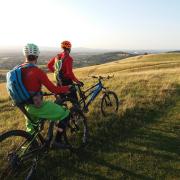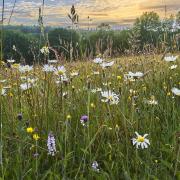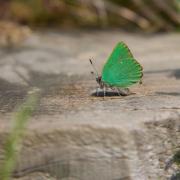Ben Jacob turned outlaw by saving orchids slated for destruction, risking prison by tracking down rare species, digging them out in the middle of the night and replanting them in safe places. Here he tells us how we too can play our part in saving these exotic beauties.
Close to the highest point in the Cotswolds, Cleeve Common offers views over Cheltenham into the hazy hills of Wales. Many visitors take in this vista without realising that something just as special and rare is located among the wildflowers growing at ground level.
Tucked away among meadow grasses there it is possible to find some little yellow-green blooms growing off stalks only about ten centimetres tall. Each flower resembles a little squid dangling five tentacles to catch the sunlight. There might be ten or 20 on each plant. These diminutive beauties are Musk orchids. Despite their name they smell of honey.

Musk orchids are one of over 50 orchid species native to Britain; many of them, including the Musk, experiencing a rapid decline in numbers. The Cotswolds are fortunate in that nationally rare habitats, where orchids grow, persist among the area’s humpbacked hills and wooded valleys. Here, the same Jurassic limestone which supplies the honey-hued façades of picturesque buildings also forms chalk grassland, a habitat many of Britain’s orchids evolved to thrive on. The Cotswolds are lucky too in that, thanks to a system of ‘Common’ land originating in the Middle Ages, some of these habitats have been protected from the ravages of urban sprawl and agriculture.

A look at some of the best sites to find orchids in the Cotswolds shows just how important the designation of common land was: Rodborough Common, Minchinhampton Common, Selsey Common, and Edge Common (now called Rudge Hill Nature Reserve) – not forgetting Cleeve Common – all offer good opportunities to spot orchids, because the land here has been left largely unchanged for centuries. As a result, over half of Britain’s native orchids can be found here.
Today managed by the National Trust, perched on the Cotswold escarpment, Minchinhampton Common’s grassland (once upon a time part of an Iron-Age Fort, a wooded landscape then partially quarried centuries ago) is a good place to look for Bee orchids rising from the grass like newly-polished velveteen gems. Each of these little jewels is a flower designed to look, feel, and even smell like a female bee sitting among pink petals to attract amorous males to mate with it. This process, known as “pseudocopulation”, is intended to get the flower pollinated without it having to produce nectar.

Even more remarkable is the fact that although Bee orchids evolved this specialised method of pollination, in the absence of their pollinators they further adapted to be able to pollinate themselves. Several varieties of Bee can be found on Minchinhampton Common, alongside the lilac steeples of Chalk Fragrant-orchids with their strong, sweet perfume, and the green-flowered Frog orchid, which, in recent years, has become increasingly rare. Greater Butterfly orchids with flowers like pale green winged serpents also grow there. At night they emit a scent of lilies.
Not all British orchids are called “orchid”: the rather mundane-looking Common Twayblade with mid-green flowers can be found in the Cotswolds – a single plant can live over a hundred years – and shady pockets of ancient woodland offer refuge to the otherworldly Bird’s-nest orchid, a species which lives off fungi instead of sunlight.
One of the rarest of all British plants is the graceful Red Helleborine: it has been found in a very limited number of sites in the Cotswolds, but commoner species, such as Broad-leaved, Violet, Narrow-lipped, and Green-flowered Helleborines with blooms like blunt-tipped stars, their lower petal modified into a special trough (the “hypochile”) filled with sweet liquid to attract insect pollinators, can be found more widely in deciduous woodland in the area.

Unfortunately, not all the chalk grassland that once clothed the Cotswolds has been saved. Today’s short-sighted planning policy allows rare habitats to be destroyed to make way for housing and transport infrastructure.
Even in protected sites, some orchid species are struggling. There are a number of reasons for this. Artificial chemicals do not respect land boundaries and affect pollinators, air, water, soil and the microscopic soil fungi which orchids need, far beyond the areas where they are released. There is recreational pressure: scenic areas struggle to accommodate day-trippers, some of whom do not know just how rare the habitat around them is and how careful they need to be. Climate breakdown is another powerful force, capable of devastating species and forever changing habitats. Hotter summers, milder winters, and extreme, unpredictable rainfall are all capable of playing havoc with delicate ecosystems which never adapted to these conditions. The Musk orchid, for example, is very prone to drought and last year’s record-breaking summer is likely to have decimated colonies, including those on Cleeve Common.
So, what can we do to preserve these areas and the rare flora and fauna which live there? Firstly, never underestimate the power of you. Despite politicians’ carefully scripted sound bites, for decades legislation and policy in this country has failed to adequately protect our nature. That is a story not exclusive to orchids and the Cotswolds: the native inhabitants of these islands are dwindling at an unsustainable rate. This should concern all of us, for biodiversity is part of the fabric which allows this planet, our economies, societies, and future generations, to function. Without policy-makers turning this into the priority it deserves to be, saving our island’s nature and our children’s future is down to us.

So, tweak what you do and how you do it, what you eat, where you buy it, how you travel, what you invest in. Learn about the complex, exquisite life on your doorstep, in your garden, in local hedgerows, and flying overhead. Learn how it all interconnects and how we too are part of that tapestry – without humans there would be no Commons, without Commons, we would not have these rare areas to enjoy alongside the rare flora which calls those oases home.
Get political: write to your MP, make your views heard on social media, object to planning proposals on rare Cotswold grassland. Most of all, we can spread the word and encourage friends, family, and colleagues to do what needs to be done. As I explore in my book, The Orchid Outlaw, in this respect our native orchids matter: they are not only biodiversity indicators, they tell a story about the planet, our place in it, and how to save it. The story they reveal concerns us all.
The Orchid Outlaw by Ben Jacob is out now (John Murray Press, £20).




























